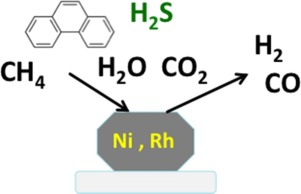当前位置:
X-MOL 学术
›
Appl. Catal. B Environ. Energy
›
论文详情
Our official English website, www.x-mol.net, welcomes your
feedback! (Note: you will need to create a separate account there.)
Effects of H2S and phenanthrene on the activity of Ni and Rh-based catalysts for the reforming of a simulated biomass-derived producer gas
Applied Catalysis B: Environment and Energy ( IF 20.2 ) Pub Date : 2017-09-06 , DOI: 10.1016/j.apcatb.2017.09.015 D. Laprune , D. Farrusseng , Y. Schuurman , F.C. Meunier , J.A.Z. Pieterse , A.M. Steele , S. Thorpe
Applied Catalysis B: Environment and Energy ( IF 20.2 ) Pub Date : 2017-09-06 , DOI: 10.1016/j.apcatb.2017.09.015 D. Laprune , D. Farrusseng , Y. Schuurman , F.C. Meunier , J.A.Z. Pieterse , A.M. Steele , S. Thorpe

|
A series of Rh and Ni-based catalysts were tested for the reforming of methane and phenanthrene using a feed composition similar in terms of main components to that of the producer gas obtained from wood gasification. The objective was to identify formulations that would enable reforming methane and tars without the need to purify the producer gas. Phenanthrene was chosen as a representative tar because this compound is produced in significant concentrations during low-temperature gasification of woody biomasses and its three-ring structure favors coke formation. The concentration of H2S used was set at the higher range of typical values, i.e. 200 ppm, to make these tests more challenging. At 900 °C, 200 ppm of H2S induced a significantly higher activity loss for methane reforming than that induced by 200 ppm of phenanthrene. The rate of methane consumption in the presence of both poisons varied linearly with the Rh metal surface area. The slight deviation observed at higher loading was in part due to heat and mass transport limitations. The rate of methane consumption per unit of metal surface area was about 5-fold higher on Rh than that on Ni. No information could be derived from the measure of apparent activation energies, due to changes in adsorption coverages of reactants and poisons with temperature. Incomplete conversion of polycyclic aromatic hydrocarbons, well-known coke precursors, was obtained at 875 °C and 850 °C.
中文翻译:

H 2 S和菲对Ni和Rh基催化剂用于重整模拟生物质衍生生产气的活性的影响
测试了一系列Rh和Ni基催化剂对甲烷和菲的重整反应,使用的进料组成的主要成分与从木材气化获得的生产气相似。目的是确定无需纯化生产气即可重整甲烷和焦油的配方。选择菲是代表性的焦油,因为该化合物是在木质生物质的低温气化过程中以高浓度产生的,并且其三环结构有利于焦炭的形成。H 2 S的使用浓度设置为较高的典型值范围,即200 ppm,以使这些测试更具挑战性。在900°C下,200 ppm H 2S引起的甲烷重整的活性损失比200ppm的菲引起的高得多。在两种毒物的存在下,甲烷的消耗速率随Rh金属表面积的变化而线性变化。在较高的负载下观察到的轻微偏差部分是由于热量和物质传输的限制。Rh上每单位金属表面积的甲烷消耗速率比Ni上高约5倍。由于反应物和毒物的吸附覆盖率随温度变化,因此无法从表观活化能的测量中得出任何信息。在875°C和850°C下获得了众所周知的焦炭前体多环芳烃的不完全转化。
更新日期:2017-09-07
中文翻译:

H 2 S和菲对Ni和Rh基催化剂用于重整模拟生物质衍生生产气的活性的影响
测试了一系列Rh和Ni基催化剂对甲烷和菲的重整反应,使用的进料组成的主要成分与从木材气化获得的生产气相似。目的是确定无需纯化生产气即可重整甲烷和焦油的配方。选择菲是代表性的焦油,因为该化合物是在木质生物质的低温气化过程中以高浓度产生的,并且其三环结构有利于焦炭的形成。H 2 S的使用浓度设置为较高的典型值范围,即200 ppm,以使这些测试更具挑战性。在900°C下,200 ppm H 2S引起的甲烷重整的活性损失比200ppm的菲引起的高得多。在两种毒物的存在下,甲烷的消耗速率随Rh金属表面积的变化而线性变化。在较高的负载下观察到的轻微偏差部分是由于热量和物质传输的限制。Rh上每单位金属表面积的甲烷消耗速率比Ni上高约5倍。由于反应物和毒物的吸附覆盖率随温度变化,因此无法从表观活化能的测量中得出任何信息。在875°C和850°C下获得了众所周知的焦炭前体多环芳烃的不完全转化。











































 京公网安备 11010802027423号
京公网安备 11010802027423号